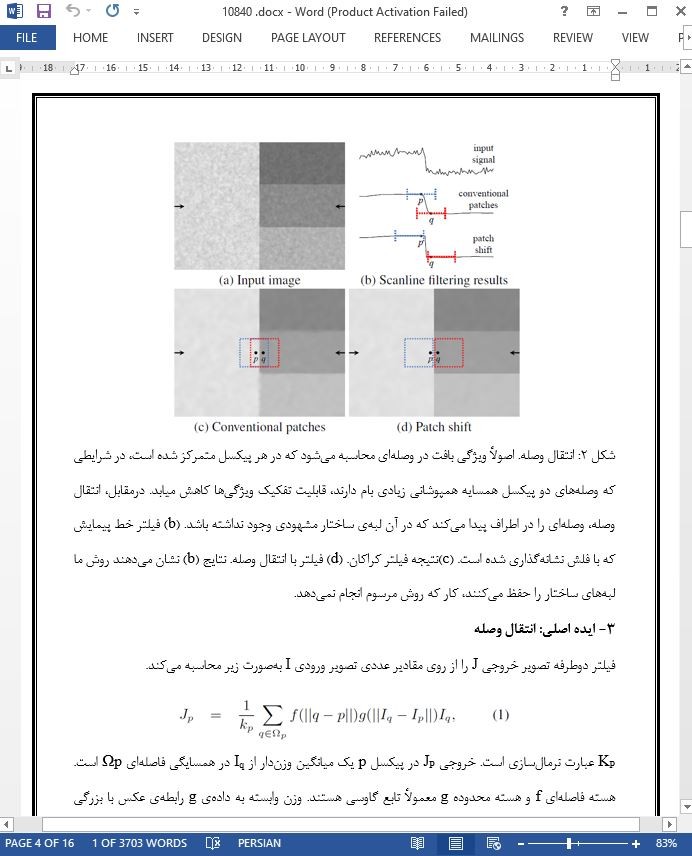
فیلتر بافت دوطرفه
چکیده
این مقاله یک عملیات جدید تجزیه تصویر با حفظ ساختار را با نام فیلتر بافت دوطرفه معرفی میکند. با تغییر کمی در عملیات فیلتر دوطرفه اصلی، روش جدید ویژگیهای بافت را بهصورت وصلهای تحلیل میکند و نتایج را با هسته فیلتر محدوده ترکیب مینماید. ایده اصلی ضامن جداسازی صحیح بافت و ساختار، بر انتقال وصله استوار است که اطلاعات بافت را از غنیترین وصلهای استخراج میکند که در آن لبههای مشهودی وجود ندارد. روش ما از نظر حذف بافت با حفظ ساختار تصویر نسبت به فیلتر دوطرفه اصلی عملکرد بهتری دارد، البته این دستاورد به بهای اضافهشدن برخی محاسبات حاصل شده است. این روش بهصورت ذاتی از مزیتهای معروف فیلتر دوطرفه برخوردار است، ازجمله: سادگی، خاصیت محلی، پیادهسازی آسان، مقیاسپذیری و سازگاری با سناریوهای کاربری دیگر.
۱- مقدمه
فیلتر حفظکننده ساختار یک عملیات ضروری است که در تحلیل تصویر و عکاسی محاسباتی کاربردهای متنوعی دارد. اینگونه عملیات یک تصویر را به ساختار مشهود و جزئیات کوچکمقیاس تجزیه میکنند و کار را برای پردازشهای بعدی مانند نگاشت تُن، بهبود جزئیات، انتزاع بصری، درک منظره و... آسان میکند. جداکردن ساختار از جزئیات، اغلب به اندازهگیری میزان مغایرت محلی وابسته است که در آن ساختار به پیکسلهای گفته میشود که تفاوت فراوانی باهم دارند. بااینحال، زمانی که جزئیات کوچکمقایس نماینگر بافت هستند، مانند شکل ۱، ممکن است روش مرسوم تجزیه تصویر شکست بخورد، زیرا اغلب آنقدر مغایرت شدید در بافت وجود دارد که موجب میشود با ساختار اشتباه گرفته شود.
۷- بحث و کارهای آتی
فیلتر بافت دوطرفهی ما سادگی فیلتر دوطرفه اصلی را همچنان داراست، بااینوجود عملکرد آن در تفکیک جزئیات بافت تصویر از ساختار آن بهبود چشمگیری دارد. انتظار داریم این سادگی، بهینگی و کارایی دروازهای به کاربردهای جدید باشد. مکانیزم انتقال وصله پیشنهادی نقش مهمی در روش ما دارد، چراکه وصله بافت و هموار برای هر پیکسل موردنیاز برای تولید تصویر راهنما را میابد. انتقال وصله یک مفهوم کلی است به هیچ نوع تعریف خاص از ویژگی بافت بستگی ندارد. بنابراین، میتوان در تحقیقهای دیگر روی پردازش تصویر کاربردهای آن را بیشتر موردبررسی قرار داد.
Abstract
This paper presents a novel structure-preserving image decomposition operator called bilateral texture filter. As a simple modification of the original bilateral filter [Tomasi and Manduchi 1998], it performs local patch-based analysis of texture features and incorporates its results into the range filter kernel. The central idea to ensure proper texture/structure separation is based on patch shift that captures the texture information from the most representative texture patch clear of prominent structure edges. Our method outperforms the original bilateral filter in removing texture while preserving main image structures, at the cost of some added computation. It inherits well-known advantages of the bilateral filter, such as simplicity, local nature, ease of implementation, scalability, and adaptability to other application scenarios.
1 Introduction
Structure-preserving filtering is an essential operation with a variety of applications in computational photography and image analysis. Such an operation decomposes an image into prominent structure and fine-scale detail, making it easier for subsequent image manipulation such as tone mapping, detail enhancement, visual abstraction, scene understanding, and other tasks. Separating structure from detail often depends on measuring the size of local contrast, where structure is identified as pixels having relatively large contrast. However, when the fine-scale detail represents texture, as in Fig. 1, the conventional way of image decomposition may fail because texture often contains strong enough contrast to get confused with structure.
7 Discussion and Future Work
Our bilateral texture filter retains the simplicity of the original bilateral filter, yet provides significantly enhanced performance in separating texture details from image structures. We expect this simplicity, efficiency, and effectiveness to open up interesting application possibilities. The proposed patch shift mechanism plays a key role in our method as it finds appropriate texture/smooth patch for each pixel that is needed to generate a guidance image. Patch shift is a general concept and does not depend on any specific definition of texture feature. Therefore, its usefulness and applicability could be further explored in a larger context of research on image processing.

چکیده
۱- مقدمه
۲- کارهای مرتبط
۳- ایده اصلی: انتقال وصله
۴- الگوریتم
۵- تحلیل
۶- نتایج
۷- بحث و کارهای آتی
Abstract
1 Introduction
2 Related Work
3 Key Idea: Patch Shift
4 Algorithm
5 Analysis
6 Results
7 Discussion and Future Work
- ترجمه فارسی مقاله با فرمت ورد (word) با قابلیت ویرایش، بدون آرم سایت ای ترجمه
- ترجمه فارسی مقاله با فرمت pdf، بدون آرم سایت ای ترجمه
